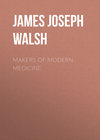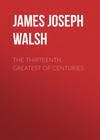Buch lesen: «The Popes and Science», Seite 33
APPENDIX VIII.
SCIENCE IN AMERICA
For Americans it is very probable that the chapter in the history of science which will demonstrate most clearly that there was not only no opposition on the part of the Popes or the Church authorities to the teachings of science or its development, but on the contrary encouragement and patronage, in spite of our English traditions to the contrary, is that which gives even very briefly the story of the evolution of science and its teaching on the American continent. Notwithstanding the very prevalent impression, indeed we might say the practically universal persuasion, that there was nothing worth while talking about in any department of education in America before the nineteenth century, except what little there was in the English colonies, and while it is confidently assumed that above all science received no attention from our Southern neighbors, Spanish America not only surpassed English America in education, but far outdistanced English America in what was accomplished for scientific research and the evolution of the knowledge of a large number of scientific subjects in a great many ways.
Even those among us who thought themselves well read in American history have, as a rule, known almost nothing of this until comparatively recent years. Professor Bourne of Yale, whose untimely death deprived the United States of a distinguished historical scholar, was the first to point out emphatically how far ahead of the English were the Spanish colonies in every mode of education, but particularly in the cultivation of science. In many places Prescott had more than hinted at this, but the materials for the whole story were not available until our time.
Some of Bourne's paragraphs represent a severe arraignment of the ignorance that has characterized so much of our supposed knowledge of the Spanish Americans and their culture in the past. After reading them it is easy to realize the truth of the expression that another distinguished university man from the United States made use of not long ago, after having visited the South American countries. He declared that it was time for North Americans to wake up and discover South America. Literally we have known almost nothing about it, indeed in a certain sense we have known much less than nothing, since we were quite sure that we knew practically all there was to know while failing to know much that as Americans we ought to have known.
Two Spanish-American universities were founded under Papal charters almost a full century before Harvard as our first small college in English America began its career. Harvard was not to be a university in any proper sense of the term for a full century and a half after its foundation, while the universities of Mexico and Peru, largely under the influence of the ecclesiastical authorities and owing nearly everything to Church patronage under the Spanish Crown, had all the essential university faculties before the close of the sixteenth century. In spite of the predominant Church influence, which, if we were to credit former English traditions, must have been fatal to the evolution of science, Professor Bourne's researches show that in the sixteenth century the Spanish-American universities were already doing such scientific work as the students in English America became interested in only during the nineteenth century. Obviously I prefer to quote Professor Bourne's own words for such startling assertions. He said in his chapter on "The Transmission of Culture" in his volume in The American Nation Series, "Spain in America":
"Not all the institutions of learning founded in Mexico in the sixteenth century can be enumerated here, but it is not too much to say that in number, range of studies and standard of attainments by the officers they surpassed anything existing in English America until the nineteenth century. Mexican scholars made distinguished achievements in some branches of science, particularly medicine and surgery, but pre-eminently linguistics, history and anthropology. Dictionaries and grammars of the native languages and histories of the Mexican institutions are an imposing proof of their scholarly devotion and intellectual activity. Conspicuous are Toribio de Motolinia's 'Historia de las Indias de Nueva España,' Duran's 'Historia de las Indias de Nueva España' but most important of all Sahagun's great work on Mexican life and religion."
Indeed, it is with regard to science in various forms that one finds the most surprising contributions from these old-time scholars. While the English in America were paying practically no attention to science, the Spaniards were deeply interested in it. Dr. Chanca, a physician who had been for several years physician-in-ordinary to the King and Queen (Ferdinand and Isabella) and was looked upon as one of the leaders of his profession in Spain, was appointed by the Crown to accompany Columbus on his second expedition, partly for the sake of the health of those who went, but also in order to make scientific notes on American subjects. The report of this scientific excursion is a valuable contribution to our knowledge of the state of science of the time and furnishes precious information with regard to Indian medicine, Indian customs, Spanish knowledge of and interest in botany and metallurgy, as well as certain phases of zoology and other scientific departments, which serves to show how wide was the training in science of this Spanish physician of over four hundred years ago. Dr. Chanca's epistle was republished as one of the Miscellaneous Publications of the Smithsonian Institution and a series of articles with regard to him from the pen of Dr. Fernandez de Ybarra has appeared in medical and other journals of the United States. Chanca is the author of a medical work on the Treatment of Pleurisy, published after his return in 1506, and a commentary on Arnold of Villanova's De conservanda juventute et retardanda senectute, "The Conservation of Youth and the Retardation of Old Age." Such a work is all the more interesting at this time because we know of De Soto's search for a "Fountain of Youth" in Florida and the popular belief in the existence of some such fabled miracle-worker for the old. Indeed most people seem inclined to think that such an idea represented very characteristically the naive medical science of the time. The Fountain of Youth was only like the many wonderful remedies–nearly always they are announced to have come from long distances–that are supposed to renew youthful vigor and which are sold so plentifully in our time. To take such popular notions as an index of the medical science of either that time or our own is quite absurd. The genuine medical science of this period is, as I have shown in my volume "The Century of Columbus," a never-ending source of surprise by its anticipation of many ideas that are usually supposed to be much later in origin and not a few of which are fondly supposed to be original discoveries of our time.
Evidently Spanish interest in science was broad and deep and this is confirmed by the story of the medical schools in connection with these Spanish-American universities which is of special significance. My own medical alma mater, the University of Pennsylvania, whose medical school was the first in the United States, erected a tablet some years ago in which it was at least hinted that this was the oldest medical school in America. A few years later, on the erection of a second tablet to the earliest medical faculty, additional knowledge having come in the meantime, the inscription on this was worded so as to refer to the first school of medicine in North America.
HOSPITAL, MEXICO (ANOTHER VIEW) This hospital, as was noted in the caption to the other view of it (opp. page 272), is the oldest foundation of this kind in America (1524) and is still in existence supported by the original endowment. The second oldest hospital in America was that of Santa Fé (in Mexico) founded in 1531 by a remarkable man who became Bishop of Michoacan, and who supported it at his own expense, besides forming at Santa Fe a community of thirty thousand Indians who lived like monks, practising hospitality and all the works of charity (A History of Nursing, Nutting and Dock, New York).
The medical school of the University of Lima, founded before the end of the sixteenth century, had meanwhile been discovered. Subsequently the medical school of the University of Mexico came to be known and the next tablet will have to be worded with due reference to that. The first chair in medicine was founded at the University of Mexico about 1580, almost two centuries before our first formal academic medical teaching in the United States was organized about 1770. During the course of a generation altogether seven chairs in medicine were founded in Mexico, including a chair of anatomy and surgery, a special chair of dissection, a chair of therapeutics and one of prognostics. The medical school of the University of Lima was organized about the same time.
With our rather complacent modern method of belittling the past and our disinclination to admit that the Spaniards were doing anything in science that the English Americans were not to think of for nearly two centuries, it would be easy to conclude that the teaching at these medical schools must have been altogether trivial and of no significance. When it is learned that most of the teaching was founded on Hippocrates and Galen some of our generation might think it hopelessly backward, but it would be well for those who think so, to be reminded that during the century following the sixteenth, Sydenham in England, and Boerhaave in Holland, the most distinguished medical men of their time who are deservedly looked up to with great reverence by most of the distinguished teachers of ours, were both of them pleading for a return to the broad, sane views and insistence on clinical observation of Hippocrates and Galen. As a matter of fact the medical schools of both the University of Mexico and of Lima were furnishing quite as good a medical training as the average medical school of Europe at that time. They were modelled closely after the Spanish universities and were in intimate relations with them, even exchanging professors and students, and at the middle of the seventeenth century at least maintaining excellent standards.
From the very beginning, then, the Spanish Americans made a definite attempt to develop scientific knowledge in America. In medicine, in botany, in pharmacology, as well as in geography, philology, ethnology, and anthropology, there are magnificent contributions made by Spanish scholars. Many a Spanish university student and teacher spent time in this country investigating the properties of plants, especially their relations to medicine, and laying precious foundations in botany. Besides there were university scholars at home in Spain taking advantage of these field investigations to compile works of serious character which are well known by those who are familiar with the history of botany and pharmacology. What the Spaniards were doing in America the Portuguese were doing in India and South Africa, and a very serious attempt was made during the sixteenth and seventeenth centuries to bring to Europe every possible material, plant or mineral, that might be of value for human health and at the same time to increase the bounds of human knowledge by careful investigation.
Nor was this thoroughly scientific and practical education confined only to the upper classes nor exclusively to those of Spanish birth and blood. Even "the wild Indians," as Bourne tells us, "were successfully gathered together in a village called a Mission where, under the increasing supervision of the friars, they were taught the elements of letters and trained to peaceful, industrious and religious lives. In fact every mission was an industrial school, where the simple arts were taught by the friars, themselves in origin plain Spanish peasants." He continues, "Spanish America, from California and Texas, to Paraguay and Chili, was fringed with such establishments, the outposts of civilization, where many thousands of Indians went through a schooling which ended only with their lives." Bourne goes so far as to say "every town, Indian as well, as Spanish, was by law required to have its church, hospital, and school for teaching Indian children Spanish and the elements of religion." The Spaniards were actually anticipating for the young Indians some of the modes of vocational education, interest in which is only just being aroused among us at the present time.
No wonder that the work of conversion in Mexico followed hard upon the heels of conquest, and to quote Bourne's words farther, "The Aztec priesthood relaxed its bonds and the masses were relieved from the earlier burdens of the faith. In the old world the progress from actual to vicarious sacrifice for sin had been slow and painful through the ages; in the new it was accomplished in but a single generation. The old religion had inculcated a relatively high morality, but its dreadful rites overhung the present life like a black cloud and for the future it offered little consolation." …"The work of the Church was rapidly adapted to the new field of labor." The triumph of the Church's influence was the preservation of the natives and their gradual uplift. This was a slow process and required almost divine patience, but it was infinitely better than the method by which the English-speaking colonies, in a chapter of history that is almost untellable in its completeness, brought the natives of the country that they had invaded to ruin and practically obliteration. This experiment in applied sociology so successfully accomplished must be placed to the credit of the Spaniards also, and it stands out with all the more interest by contrast with English neglect of duty.
While seeing so clearly all that was accomplished in Mexico under the influence of the Church for education and social progress and scientific teaching and training in the arts and crafts and trades, Professor Bourne cannot quite bring himself to condemn entirely the almost complete failure that characterized all the relations of the English-speaking peoples to the natives here in America and he even seems to find some justification for their harsh treatment of the Indians. I think that our point of view generally has changed a great deal in this matter even in the last ten or fifteen years since we have come to recognize our social obligations more clearly and, above all, have come to appreciate better what is meant by "the white man's burden" in his relations to the dark-skinned peoples who are lower in the scale of civilization than we are. The Civil War did much to correct American notions on this point, but our attention to problems in the Philippines has done even more. I shall leave Professor Bourne's paragraph to speak for itself and each reader to say for himself whether the English method of dealing with the Indian is justified by comparison with the ruthless processes of nature as Professor Bourne would hint.
"Far different was the advancing frontier in English America with its clean sweep, its clash of elemental human forces. Our own method prepared a home for a more advanced civilization and a less variously mixed population and its present fruits seem to justify it as the ruthless processes of nature are justified; but a comparison of the two systems does not warrant self-righteousness on the part of the English in America."
Indeed we might well say far from it, for the almost literal obliteration of the Indian in North America as of the natives in Australia and New Zealand, only so much more complete there, represents ever to be regretted blots on the history of civilization for which there can be no possible justification.
Professor Bourne does not hesitate to continue the comparison of Spanish and English America down even to our own time and in doing so points out that our advances which have for the time being put us so far ahead of the Spanish Americans are mostly the gains of the age of steam and are due to the fact that it was hard for their mixed population with so many barbarous elements in them to keep up with our comparatively homogeneous population, homogeneous at least in the sense of coming from the same strata and civilization in Europe. While our Indians have been almost entirely obliterated there are more Indians alive in Mexico and in South America to-day than there were when Columbus landed. With this fact in mind Professor Bourne's comparison and contrast takes on renewed interest and his apology for the Spanish Americans is all the more telling.
"If we compare Spanish America with the United States a hundred years ago we must recognize that while in the North there was a sounder body politic, a purer social life and a more general dissemination of elementary education, yet in Spanish America there were both vastly greater wealth and greater poverty, more imposing monuments of civilization, such as public buildings, institutions of learning and hospitals, more populous and richer cities, a higher attainment in certain branches of science. No one can read Humboldt's account of the City of Mexico and its establishments for the promotion of science and the fine arts without realizing that whatever may be the superiorities of the United States over Mexico in these respects, they have been mostly the gains of the age of steam."
If one reads Champlain's account of the City of Mexico as he saw it at the very beginning of the seventeenth century, as I have quoted it in the chapter "America in Columbus' Century," in "The Century of Columbus" (Catholic Summer School Press. New York, 1914), it will be quite clear that Humboldt was only seeing the natural development of culture and artistic progress that was already in evidence in the early sixteenth century.
"During the first half-century," Bourne continues, "after the application of steam to transportation Mexico weltered in domestic turmoils arising out of the crash of the old regime. If the rule of Spain could have lasted half a century longer, being progressively as it was during the reign of Charles III; if a succession of such viceroys as Revilla Gigedo, in Mexico, and De Croix and De Taboaday Lemos, in Peru, could have borne sway in America until railroads could have been built, intercolonial intercourse ramified, a distinctly Spanish-American federal State might possibly have been created, capable of self-defence against Europe, and inviting cooperation rather than aggression from the neighbor in the North."
If the effort to understand Spanish America now so manifest will only go to the extent of having our people realize the full truth that until the nineteenth century English America was far behind Spanish America in facilities for higher education, in culture and literature, in the application of the arts to municipal life and, above all, in interest in science, then the prevalent impression that the Popes and the Catholic Church are opposed to genuine progress and true science will disappear. Catholic America was far ahead of Protestant America in scientific education and research until the untimely break from Spain left the Spanish-American countries the prey of political disturbances.
APPENDIX IX.
THE DANGER OF A LITTLE KNOWLEDGE
Professor Draper's "The History of the Conflict between Religion and Science."
What I have tried to emphasize in this volume is that the arguments advanced to show the opposition of the Catholic Church to science are founded on actual ignorance of the history of science or misunderstandings of particular incidents of that history. Not only was there no policy of opposition to science, but on the contrary encouragement of interest in scientific subjects, patronage of scientific workers and even definite endowment of scientific research by the ecclesiastical authorities. The tradition of Church opposition to science is founded especially on lack of knowledge of what was done for science in the medieval period and a misunderstanding of the medieval universities. This tradition owed its origin partly to the Renaissance, which, having rediscovered Greek, despised whatever Western Europe had accomplished during the preceding centuries and spoke of all that was done as Gothic, as if only worthy of barbarous Gothic ancestors.
Another large factor, however, in the creation of this tradition and one which meant more for us here in America than the Renaissance, was the religious revolt of the sixteenth century in Germany which has been called the Reformation. The reformers made it a point to minimize, if not actually to misrepresent, what had been accomplished under the old Church regime, and this Protestant tradition lived on here in America with much more vitality even than in Europe.
The consequence was the bringing up of a series of generations, who, if not actually believing as so many absurdly did, that the Pope of Rome was the Scarlet Woman and the Church the Babylon of the Apocalypse, were quite sure at least that no good could possibly have come out of the Nazareth of pre-Reformation times. It is only in recent years that we have come to recognize that all the talk about the Dark Ages is, as John Fiske said, simply due to ignorance of the time and its accomplishment. The later medieval period might well be called the "Bright Ages" for its art and architecture, its magnificent literature, its interest in education and in scholarship, its development of democracy and its formulation of the great laws and constitutions by which the rights of men were guaranteed in practically every country in Europe. Just as soon as this true state of affairs with regard to the medieval period is recognized, then all question of any policy of Church opposition to education and science disappears.
I have illustrated the lack of knowledge of the true history of science as the basis of the arguments for the thesis of Church opposition to science in the present volume by impugning what President White advances as facts. It can be illustrated still better, however, from another book written twenty years before President White's, even a little consideration of which shows how the whole status of the arguments with regard to the relations of Church and science has changed during a single generation. Our growing knowledge of history has literally taken away all the ground on which the older controversialists used to stand. This is the "History of the Conflict Between Religion and Science" by Professor John W. Draper, which was issued in 1874, just forty years ago, and already in 1875 had entered its third edition, so that the book sold almost as a popular novel at that time and evidently attracted wide attention. The volume was accorded the privilege of publication in the International Scientific Series, and as this set is among the recognized serious books of the time, some of them classics in science and most of them representing important contributions to knowledge, no wonder most readers never thought of doubting its authority or above all questioning its "facts."
Some of Dr. Draper's work made him deservedly one of the best-known biological scientists of the United States in his time. He had had a very striking career. As a medical student at the University of Pennsylvania he reported in his thesis for the doctorate in medicine, which had become at this time usually such a commonplace statement of conventional science that it was shortly after given up as a requirement, a series of observations on absorption through membranes, using bubbles for his experimental work, that attracted the special commendation of the faculty and the attention of the scientific world. He was not yet thirty years of age when he made the first photograph of a human being–that of his sister–ever made and in 1840 successfully secured the first photographs of the moon. During the next ten years he made a series of observations on the spectrum which attracted deserved attention and anticipated not a little of Kirchoff's work. Melloni, himself a distinguished Italian physicist, reported these observations to the academy of Naples. Draper's text-book of physiology was without doubt the best medical text-book issued in America up to that time and deservedly held its place for many years in our medical schools.
It was no wonder then that Draper received many distinctions in the shape of membership in foreign scientific societies, honorable mentions, and prizes. His works were translated into many of the European languages. Late in life he gave up his experimental and scientific work to devote himself to the writing of history. His history of the Civil War was widely read both in Europe and America. His "History of the Intellectual Development of Europe," which only a little reading now in the light of recent knowledge of the Middle Ages shows us to be a caricature of the philosophy of history, was translated into several foreign languages and was probably more widely read than any serious work by an American author up to that time. What was very rare for an American book at that period it was read by a great many European teachers and students. All this gave added distinction to his writing on the subject of the relations of science and religion, and so it is easy to understand that he was considered by many to have made an almost final summary of this important controversy.
Professor Draper's book then became a sort of bible, that is a book of books, for a great many American teachers of science and, above all, for the younger generation of university lecturers who were to have the shaping of opinions among the students of scientific departments of our colleges and universities during the last quarter of the nineteenth century. It does not seem too much to assume that most of the maturer scientists who are now teaching in the university scientific departments of this country, read Professor Draper's book and were led by it to an almost unshakeable conviction that religion and, above all, the Catholic Church, fearful lest science should take men away from her influence, had been constantly opposed to all true scientific progress, and what was more unpardonable, that religion as represented by the Church had been for the same reason a bitter enemy of any and every social progress that might lead to the real development of mankind. For them under Draper's inspiration it seemed that the deliberate Church policy was that if men were not happy here they would look with all the more eagerness to happiness hereafter and take all the means offered by the Church to secure it. That such a conclusion impugned the motives of millions of men whom their own generation had thoroughly respected and yielded to the most dangerous of human ideas, suspicion, made no difference. No good could come out of the Nazareth of the Catholic Church.
It is quite certain that a great many of the younger teachers of science of that time who are still alive, even when not entirely conscious of the source of their opinions as to the relations of science and religion and the Church and education, have at the back of their minds certain prejudices, founded on the influence produced on them during their plastic, formative state of mind by the reading of Professor Draper's book. Indeed, so firm is the feeling in many of these men, that this whole subject is settled for them beyond the possibility of any modification, that they have insulated their minds from any further currents of information.
Controversy is distasteful at best; to find out that one has been cherishing a mistaken notion for years, is always disturbing as one grows older, and so it is not surprising that many of these men frequently use expressions with regard to the supposed relations of Church and science that are quite incompatible with what is now very generally known of the history of science. Their minds are made up, and they simply refuse to bring for a second time any of these subjects before the bar of judgment. Besides, though they would resent any such imputation as to their own state of mind, they have the feeling that people with religious convictions are prone to see only one side, and, therefore, anything that may be said on the other side is only a bit of special pleading for a conviction that no reasoning and no argument would change. They argue, as a consequence, that it would be quite useless for them to read the other side with any reasonable hope of getting at the real facts. This attitude of scientists is very different from the open-mindedness that is supposed to be characteristic of the devotees of science; but it is very human.
Now the interesting fact with regard to Professor Draper's books is that Professor Draper, a scientist, did not know the history of science at all. He was entirely ignorant of the great advances that were even then being made, with regard to our knowledge of the growth of science during the medieval period. He thought that there was very little, indeed practically no science, during that period. Looking about for a reason, he made the Church a scapegoat. The publication during the past generation of many German volumes on the history of the different sciences–and these German students went straight to the original documents–has shown us that there were magnificent developments of science during the medieval and early Renaissance periods, when the Church was in control of the educational institutions and of every phase of academic work. The story of the opposition between religion and science falls to the ground at once when these facts are known. Some of them were already in process of publication even in Draper's time, but he knew nothing of them. He was so sure that there was nothing to know in this matter, that he probably did not bother his head very much about trying to get the latest results of scholarship in the matter.


















